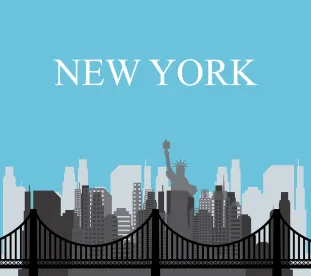In this episode of The Proskauer Brief, partner Evandro Gigante and associate Laura Fant discuss the recent New York law prohibiting discrimination on the basis of certain hairstyles. This law expands the definition of race under the New York State Human Rights Law to now expressly include “traits historically associated with race,” which include but are not limited to hair texture and protective hairstyles. Employers should tune in to see what impact the new law may have on the scope of race discrimination claims and what changes to polices or practices should be implemented when thinking about this new law.
Laura Fant: Hello, welcome to the Proskauer Brief. Hot topics on labor and employment law. I’m Laura Fant and I’m here today with Evandro Gigante. And on today’s episode we’re going to discuss the recent New York law prohibiting discrimination on the basis of certain hairstyles. So Evandro, what’s this new law all about?
Evandro Gigante: Laura, the new law expands the definition of race under the New York State Human Rights Law to now expressly include traits historically associated with race, which include but are not limited to hair texture and protective hair style. So, in essence the discrimination protections are now clearer that employers cannot discriminate against individuals based on traits that may be associated with race to include their hair texture and protective hairstyles, and it interestingly remains to be seen to what extent the law may extend even beyond hair texture and hairstyle. The language of the statute which I just mentioned actually says that race includes “traits historically associated with race including but not limited to hair texture and protective hairstyles”. So as a result, it’s interesting to think about what potential categories or traits may be protected beyond hairstyles although that was not expressly contemplated in the statute as written.
Laura, now have any other states across the country passed similar laws?
Fant: So, currently California is the only other state that has enacted a specific law protecting hairstyles and as you mentioned other traits historically associated with race. The California law is in fact very close in language to the New York law and provides the same general protections for hair texture, styles, and other traits associated with race. Additionally, you may remember back in February of this year, 2019, the New York City Commission on Human Rights released what they call legal enforcement guidance on race discrimination on the basis of hair. So that guidance addressed the New York City Human Rights law and the guidance stated that that law protects the rights of New Yorkers to “maintain natural hair or hairstyles that are closely associated with their racial, ethnic, or cultural identities.” Now while the City’s guidance doesn’t have the force of law in the same way that a statute or regulations would, it does shine a light into how the City Commission would evaluate a complaint of discrimination that’s based on hairstyle.
Now Evandro what impact do you think that this new state law will have on claims of workplace discrimination?
Gigante: So I think that the impact will be to broaden the scope of race discrimination claims that one can bring. Previously of course it had been the case that if an employee wanted to challenge an employer’s directive or disciplinary decision that was targeted towards, for example, one’s hairstyle the employee would have to show that the object of the directive or the discipline was really the employee’s race. Now it seems to be that that nexus would already be drawn by virtue of the statute itself. Right? Which recognizes that hair texture and protective hairstyles are traits that are historically associated with race and in fact the law even goes a bit further to define protective hairstyles to include hairstyles such as braids, locks, and twists. So, it would seem to me that the category of claims that could be brought based on race would be broadened by virtue of the fact that an employee could now challenge an employer’s decision to either issue discipline or impose some type of policy or rule based on, for example, protective hairstyles like braids, locks, and twists without having to draw some direct connection to that individual’s race.
Fant: So not only a broader universe of claims but the potentially easier to prove those claims?
Gigante: That’s right. So Laura, now that the law has been passed in New York how would HR in your view respond when issues of hair discrimination are brought to their attention?
Fant: Well because this is simply an expansion of the existing New York State Human Rights Law protections against race discrimination, I think HR really should respond to a complaint of hair discrimination in the very same way they would any other type of discrimination complaint. You know that is by investigating the allegation promptly, thoroughly and taking any appropriate corrective action that they deem to be necessary once they conclude that investigation.
Gigante: Agreed.
Fant: Now Evandro, as a practical matter what if any changes to polices or practices should employers be thinking about in connection with this new law which, I understand has already taken effect?
Gigante: Well interestingly this is a bit different than for example other statutory amendments which add a protective category. In this case the State actually amended the law to include within the definition of race the traits that we have been talking about. So there’s no express requirement in the law that the traits associated with race be enumerated in a policy. So what that means is that there’s no real express requirement to really amend or change a policy which presumably already prohibits discrimination on the basis of race. Of course employers can consider if they would like to go beyond what the minimum requirement would be and actually enumerate traits historically associated with race like hair texture and protective hairstyles but that type of amendment would not necessarily be required based on the new statute.
Fant: Now what about dress codes or grooming policies? Anything that employers should be thinking about there?
Gigante: So I do think that employers should review their dress code and grooming policies to make sure that there’s nothing in there that could run afoul of the law. Remember the law will now say that traits historically associated with race like hair texture and protective hairstyles which could include, again, braids, locks, and twists, right, can be basis on which someone can bring a claim of discrimination. So you want to make sure that your policies aren’t touching on those types of details. And in fact if it’s the case that for example long hair can pose a safety risk in the workplace, instead of enumerating the specific types of hairstyles that could pose a risk, maybe it’s better to simply say that hair must be shorter than a certain length or otherwise secured at all times rather than be so specific with what types of hairstyles may be violation of the policy.
Fant: That makes sense. I think that’s good advice as a general matter.
Gigante: Laura, can we expect to see more of these laws coming in the future?
Fant: I think it’s very possible. You know oftentimes we see that once states like New York and California pass laws in a particular area or on a particular subject other states tend to fall in line and follow shortly thereafter. And in fact we are seeing that. The New Jersey State Legislature is currently considering a very similar law, worded very similarly to the existing New York and California laws. And just last week the Michigan Legislature also introduced a similar bill. So I think this is definitely something that employers across the country should keep an eye on.
Gigante: Great, and we’ll be on the lookout as well. Well thank you for joining us on the Proskauer Brief today. Stay tuned for more insights on the latest hot topics in labor and employment law. And be sure to follow us on iTunes, Spotify and Google Play.
In this episode of The Proskauer Brief, partner Evandro Gigante and associate Laura Fant discuss the recent New York law prohibiting discrimination on the basis of certain hairstyles. This law expands the definition of race under the New York State Human Rights Law to now expressly include “traits historically associated with race,” which include but are not limited to hair texture and protective hairstyles. Employers should tune in to see what impact the new law may have on the scope of race discrimination claims and what changes to polices or practices should be implemented when thinking about this new law. play podcast Listen to the podcast. Laura Fant: Hello, welcome to the Proskauer Brief. Hot topics on labor and employment law. I’m Laura Fant and I’m here today with Evandro Gigante. And on today’s episode we’re going to discuss the recent New York law prohibiting discrimination on the basis of certain hairstyles. So Evandro, what’s this new law all about? Evandro Gigante: Laura, the new law expands the definition of race under the New York State Human Rights Law to now expressly include traits historically associated with race, which include but are not limited to hair texture and protective hair style. So, in essence the discrimination protections are now clearer that employers cannot discriminate against individuals based on traits that may be associated with race to include their hair texture and protective hairstyles, and it interestingly remains to be seen to what extent the law may extend even beyond hair texture and hairstyle. The language of the statute which I just mentioned actually says that race includes “traits historically associated with race including but not limited to hair texture and protective hairstyles”. So as a result, it’s interesting to think about what potential categories or traits may be protected beyond hairstyles although that was not expressly contemplated in the statute as written. Laura, now have any other states across the country passed similar laws? Fant: So, currently California is the only other state that has enacted a specific law protecting hairstyles and as you mentioned other traits historically associated with race. The California law is in fact very close in language to the New York law and provides the same general protections for hair texture, styles, and other traits associated with race. Additionally, you may remember back in February of this year, 2019, the New York City Commission on Human Rights released what they call legal enforcement guidance on race discrimination on the basis of hair. So that guidance addressed the New York City Human Rights law and the guidance stated that that law protects the rights of New Yorkers to “maintain natural hair or hairstyles that are closely associated with their racial, ethnic, or cultural identities.” Now while the City’s guidance doesn’t have the force of law in the same way that a statute or regulations would, it does shine a light into how the City Commission would evaluate a complaint of discrimination that’s based on hairstyle. Now Evandro what impact do you think that this new state law will have on claims of workplace discrimination? Gigante: So I think that the impact will be to broaden the scope of race discrimination claims that one can bring. Previously of course it had been the case that if an employee wanted to challenge an employer’s directive or disciplinary decision that was targeted towards, for example, one’s hairstyle the employee would have to show that the object of the directive or the discipline was really the employee’s race. Now it seems to be that that nexus would already be drawn by virtue of the statute itself. Right? Which recognizes that hair texture and protective hairstyles are traits that are historically associated with race and in fact the law even goes a bit further to define protective hairstyles to include hairstyles such as braids, locks, and twists. So, it would seem to me that the category of claims that could be brought based on race would be broadened by virtue of the fact that an employee could now challenge an employer’s decision to either issue discipline or impose some type of policy or rule based on, for example, protective hairstyles like braids, locks, and twists without having to draw some direct connection to that individual’s race. Fant: So not only a broader universe of claims but the potentially easier to prove those claims? Gigante: That’s right. So Laura, now that the law has been passed in New York how would HR in your view respond when issues of hair discrimination are brought to their attention? Fant: Well because this is simply an expansion of the existing New York State Human Rights Law protections against race discrimination, I think HR really should respond to a complaint of hair discrimination in the very same way they would any other type of discrimination complaint. You know that is by investigating the allegation promptly, thoroughly and taking any appropriate corrective action that they deem to be necessary once they conclude that investigation. Gigante: Agreed. Fant: Now Evandro, as a practical matter what if any changes to polices or practices should employers be thinking about in connection with this new law which, I understand has already taken effect? Gigante: Well interestingly this is a bit different than for example other statutory amendments which add a protective category. In this case the State actually amended the law to include within the definition of race the traits that we have been talking about. So there’s no express requirement in the law that the traits associated with race be enumerated in a policy. So what that means is that there’s no real express requirement to really amend or change a policy which presumably already prohibits discrimination on the basis of race. Of course employers can consider if they would like to go beyond what the minimum requirement would be and actually enumerate traits historically associated with race like hair texture and protective hairstyles but that type of amendment would not necessarily be required based on the new statute. Fant: Now what about dress codes or grooming policies? Anything that employers should be thinking about there? Gigante: So I do think that employers should review their dress code and grooming policies to make sure that there’s nothing in there that could run afoul of the law. Remember the law will now say that traits historically associated with race like hair texture and protective hairstyles which could include, again, braids, locks, and twists, right, can be basis on which someone can bring a claim of discrimination. So you want to make sure that your policies aren’t touching on those types of details. And in fact if it’s the case that for example long hair can pose a safety risk in the workplace, instead of enumerating the specific types of hairstyles that could pose a risk, maybe it’s better to simply say that hair must be shorter than a certain length or otherwise secured at all times rather than be so specific with what types of hairstyles may be violation of the policy. Fant: That makes sense. I think that’s good advice as a general matter. Gigante: Laura, can we expect to see more of these laws coming in the future? Fant: I think it’s very possible. You know oftentimes we see that once states like New York and California pass laws in a particular area or on a particular subject other states tend to fall in line and follow shortly thereafter. And in fact we are seeing that. The New Jersey State Legislature is currently considering a very similar law, worded very similarly to the existing New York and California laws. And just last week the Michigan Legislature also introduced a similar bill. So I think this is definitely something that employers across the country should keep an eye on. Gigante: Great, and we’ll be on the lookout as well. Well thank you for joining us on the Proskauer Brief today. Stay tuned for more insights on the latest hot topics in labor and employment law. And be sure to follow us on iTunes, Spotify and Google Play.




 />i
/>i

